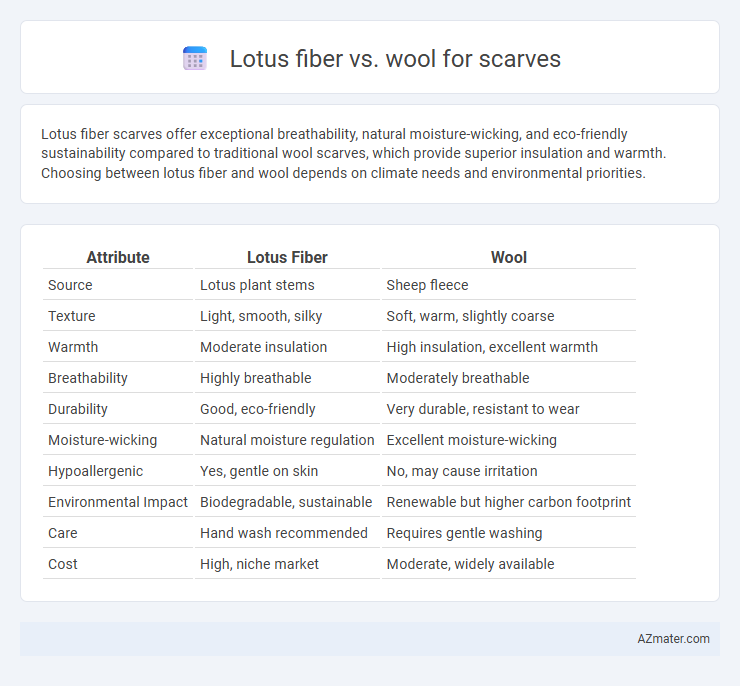Lotus fiber scarves offer exceptional breathability, natural moisture-wicking, and eco-friendly sustainability compared to traditional wool scarves, which provide superior insulation and warmth. Choosing between lotus fiber and wool depends on climate needs and environmental priorities.
Table of Comparison
| Attribute | Lotus Fiber | Wool |
|---|---|---|
| Source | Lotus plant stems | Sheep fleece |
| Texture | Light, smooth, silky | Soft, warm, slightly coarse |
| Warmth | Moderate insulation | High insulation, excellent warmth |
| Breathability | Highly breathable | Moderately breathable |
| Durability | Good, eco-friendly | Very durable, resistant to wear |
| Moisture-wicking | Natural moisture regulation | Excellent moisture-wicking |
| Hypoallergenic | Yes, gentle on skin | No, may cause irritation |
| Environmental Impact | Biodegradable, sustainable | Renewable but higher carbon footprint |
| Care | Hand wash recommended | Requires gentle washing |
| Cost | High, niche market | Moderate, widely available |
Introduction to Lotus Fiber and Wool
Lotus fiber, derived from the stems of lotus plants, is a rare and eco-friendly natural material known for its lightweight, silky texture, and breathable properties, making it ideal for scarves. Wool, sourced from sheep, offers excellent warmth, moisture-wicking ability, and durability, frequently used for winter scarves due to its insulating qualities. Comparing lotus fiber and wool highlights differences in sustainability, texture, and temperature regulation suitable for various scarf preferences.
Origins and Production Processes
Lotus fiber, derived from the stems of lotus plants through a delicate hand-extraction process, originates primarily in Myanmar and Vietnam, where traditional techniques preserve its natural luster and lightweight properties. Wool, sourced predominantly from sheep breeds such as Merino and Shetland, involves shearing, cleansing, carding, and spinning to produce a warm, insulating fiber widely cultivated in Australia, New Zealand, and Europe. The ecological impact of lotus fiber is relatively low due to its sustainable harvesting and minimal chemical use, contrasting with wool's energy-intensive production and land requirements associated with sheep farming.
Texture and Feel: Lotus Fiber vs Wool
Lotus fiber scarves offer a unique, smooth texture with a soft yet slightly crisp feel, making them lightweight and breathable compared to wool. Wool scarves provide a warm, dense texture with natural insulation and a cozy, plush feel ideal for colder climates. The moisture-wicking and hypoallergenic properties of lotus fiber contrast with wool's natural warmth and elasticity, influencing the overall comfort and tactile experience.
Breathability and Comfort
Lotus fiber offers exceptional breathability due to its natural hollow structure, allowing air to circulate and moisture to evaporate quickly, making it ideal for warm climates. Wool, while renowned for its insulating properties, also provides good breathability by wicking moisture away from the skin and regulating temperature effectively. Both fibers ensure comfort, but lotus fiber's lightweight and smooth texture often results in a cooler, softer feel compared to the denser, sometimes itchier nature of wool.
Warmth and Insulation Properties
Lotus fiber offers superior breathability and natural moisture-wicking properties, making it ideal for lightweight scarves in mild climates, but it provides less warmth compared to wool. Wool excels in insulation due to its crimped fibers trapping air, offering excellent heat retention and moisture resistance, perfect for cold weather scarves. Choosing between lotus fiber and wool depends on the desired balance of lightweight comfort versus maximum warmth and insulation.
Durability and Longevity
Lotus fiber scarves offer exceptional durability due to the natural strength of the fiber, which resists wear and tear while maintaining softness. Wool provides excellent longevity through its resilience and ability to retain shape and warmth over time, even with frequent use. Comparing both, lotus fiber tends to last longer in humid conditions as it resists mildew, whereas wool excels in insulation and abrasion resistance in varied climates.
Sustainability and Eco-Friendliness
Lotus fiber is highly sustainable due to its biodegradable nature and low water usage during cultivation, whereas wool production involves intensive land and water resources and raises ethical concerns about animal welfare. Lotus fiber is harvested by extracting fibers from lotus stems without harming the plant, resulting in a renewable and eco-friendly textile ideal for scarves. Wool, although natural and durable, often requires chemical treatments and extensive grazing that contribute to environmental degradation.
Maintenance and Care Tips
Lotus fiber scarves require gentle hand washing with mild detergent and air drying to maintain their natural sheen and durability, avoiding high heat to prevent damage. Wool scarves benefit from cold water washing or dry cleaning, with careful reshaping and flat drying to preserve softness and reduce pilling. Proper storage in a cool, dry place prevents moth infestations for both fibers, ensuring longevity and maintaining scarf quality.
Price Comparison and Accessibility
Lotus fiber scarves are generally priced higher than wool scarves due to the labor-intensive harvesting and processing required for lotus stems. Wool scarves benefit from widespread availability and mass production, making them more accessible and affordable in most markets. Consumers seeking eco-friendly or luxury options may prefer lotus fiber despite the premium cost, while budget-conscious buyers often favor the convenience and lower price of wool scarves.
Choosing the Right Scarf: Lotus Fiber or Wool?
Lotus fiber scarves offer exceptional breathability, hypoallergenic properties, and natural sheen, making them ideal for sensitive skin and warm climates. Wool scarves provide superior warmth, durability, and moisture-wicking capabilities, suitable for colder environments and outdoor activities. Selecting between lotus fiber and wool depends on your climate needs, skin sensitivity, and desired scarf texture.

Infographic: Lotus fiber vs Wool for Scarf
 azmater.com
azmater.com